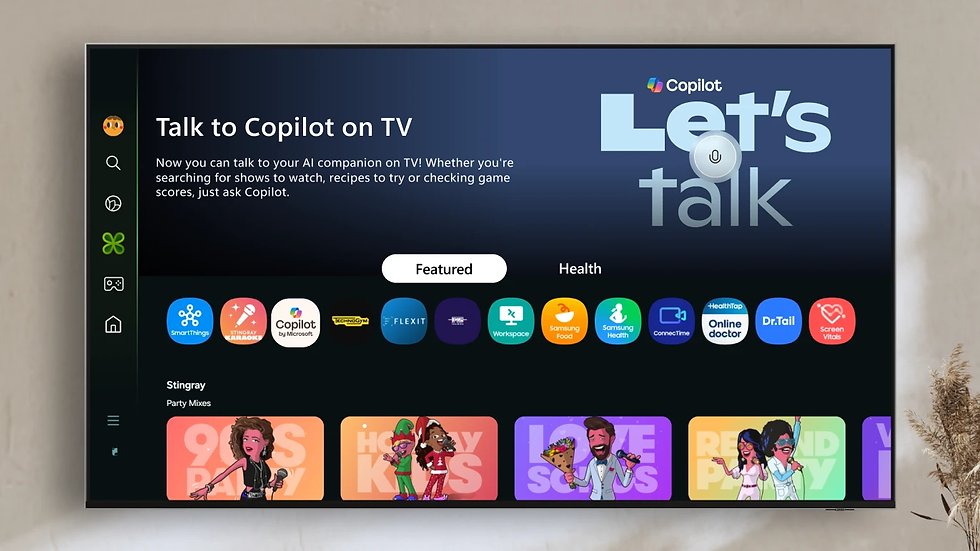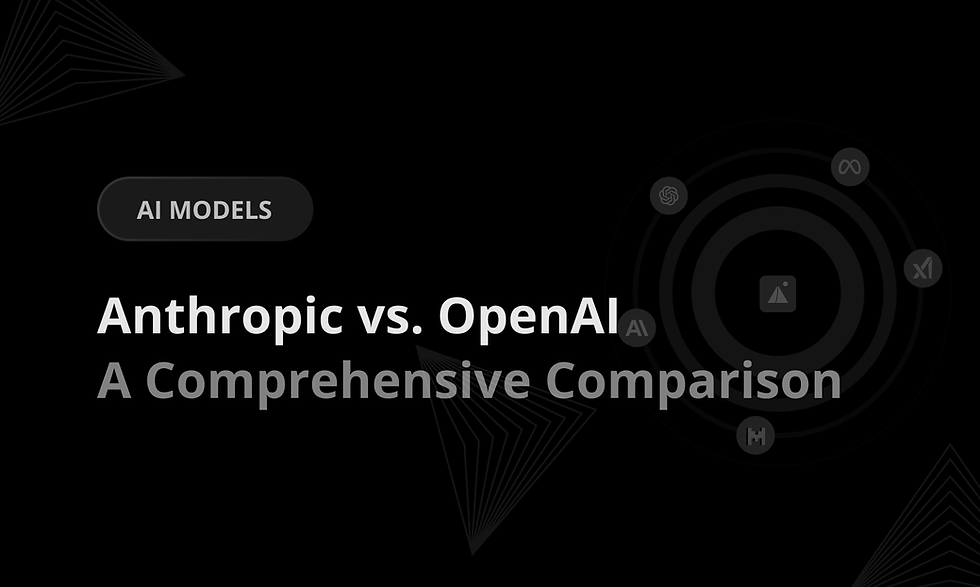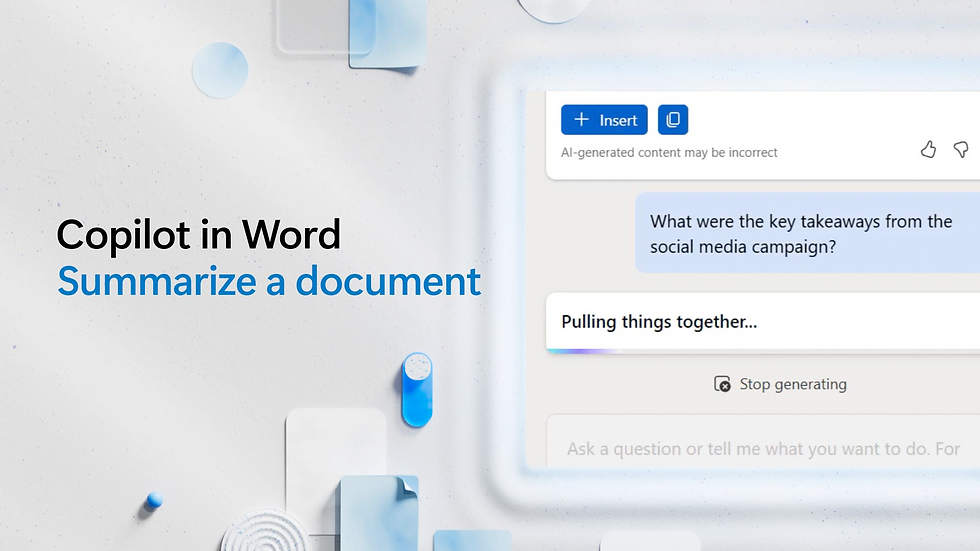Microsoft to Integrate Anthropic AI Models into Office 365, Reducing Dependence on OpenAI
- Ethan Carter

- Sep 11
- 10 min read

Microsoft Copilot integration with Anthropic AI models
Microsoft announced formal integration of Anthropic’s AI models into Microsoft Copilot and Microsoft 365 Copilot, saying the change is intended to give users and enterprises selectable model backends and reduce reliance on any single provider. In plain terms: Copilot — the generative assistant Microsoft embeds across its products — will be able to route requests to Anthropic’s Claude family alongside the models it already supports. This is presented as product-level multi-model support rather than a swap-out of existing providers.
Copilot here refers to two related concepts: the endpoint-level assistant that handles conversational requests and the Microsoft 365 Copilot integrations that sit inside Word, Excel, Outlook and Teams to assist with writing, summarizing and workflow automation. Microsoft frames the update as a way to improve productivity, safety and resilience by letting organizations choose which model backend powers specific Copilot experiences. For administrators, “tenant” controls (the workspace settings for an organization’s Microsoft 365 subscription) will govern which model endpoints are available to users.
Microsoft positioned the move as part of a broader Copilot expansion to diversify model options, while press outlets have read it as a strategic step to reduce operational and contractual dependence on a single supplier. The Financial Times, for example, framed the announcement in the context of Microsoft’s wider AI sourcing strategy and enterprise risk management.
Insight: multi-model support is about choice and resilience as much as capability — offering different trade-offs for safety, tone and latency.
Key takeaway: Microsoft’s Anthropic integration is a deliberate product-level move to broaden model choice inside Copilot and give enterprise admins new control over backend selection.
Anthropic AI models in Microsoft Copilot

What changes for users and where Anthropic will appear
Microsoft’s announcement explains that both Microsoft Copilot (endpoint-level assistant) and Microsoft 365 Copilot (app-integrated assistant) will support Anthropic model endpoints alongside existing models. Practically, that means when a user asks Copilot to draft an email, generate a spreadsheet formula, or summarize a meeting, an administrator-configured routing policy can send the job to an Anthropic Claude model instead of (or as a fallback to) other providers.
Define: a model endpoint is the API-accessible address where a particular AI model runs; routing requests to different endpoints is how Copilot can offer “multi‑model” experiences.
Choice of model backend and response characteristics
Providing Anthropic as an option is not purely cosmetic. Different model families emphasize distinct trade-offs: Anthropic has marketed its Claude models around safety and steerability, which can translate into gentler, more conservative response styles in workplace settings. Microsoft expects selectable backends to let organizations choose models that better match their tone, risk profile, or compliance needs.
Microsoft frames the change as multi-model support, not a replacement of existing providers, meaning users will see choices rather than forced migration. Expect subtle differences in phrasing, sensitivity to prompts, and how each backend handles content filters.
Admin and enterprise controls for safe rollout
Administrators will control which models are available inside a tenant and can apply policy settings to restrict usage by user group, region, or SKU. This administrative gating is central: enterprises often need to restrict experimental backends to small pilot groups before wider rollout.
Microsoft pairs the integration with its responsible AI commitments and guardrails, promising that Anthropic-powered responses will flow through the same compliance and safety workflows Copilot already uses. In practice, that means data handling, telemetry, and red-teaming processes will be applied uniformly across model backends where possible.
Insight: model choice becomes an IT governance decision as much as an end-user preference — shaping tone, safety posture and compliance coverage across the organization.
Key takeaway: Anthropic models will appear as selectable backends inside Copilot, with admin controls and Microsoft’s responsible-AI tooling applied across providers to maintain governance and compliance.
Specs and performance comparisons — Anthropic models versus OpenAI in Office 365
What Microsoft published and what it did not
Microsoft’s public posts emphasize multi-model flexibility and vendor diversification, but they stop short of single-number benchmarks. The announcement describes Anthropic models as complementary options targeting different trade‑offs (safety, response style, latency), rather than claiming blanket superiority. That phrasing is intentional: enterprise workloads vary (large context summaries, formula generation, meeting extraction), so providers may outperform on different axes.
Without standardized internal benchmarks from Microsoft, head-to-head latency, throughput, or accuracy comparisons inside Copilot remain empirical questions for pilots.
Technical integration notes and community how-tos
On the implementation side, Microsoft recommends standard API-based model routing and tenant-level configuration for enabling alternative model endpoints. Several third-party platforms and connector vendors have already published guides for wiring Anthropic into Microsoft 365 flows: tools like Pipedream, AppyPie, Integrately and Viasocket provide practical tutorials and prebuilt connectors that help teams handle authentication, request formatting and basic error handling when routing Copilot requests to Anthropic endpoints. See the Pipedream Anthropic + Office 365 integration guide and the AppyPie Claude + Office 365 integration page for examples of these engineering patterns.
Interoperability, protocols and scaling concerns
A technical pain point for multi‑model orchestration is interoperability: different model vendors adopt distinct protocols and context-transfer conventions. Recent academic work examines issues such as Anthropic’s proposed Model Context Protocol (MCP) versus other agent-to-agent standards like Google’s A2A. Research into MCP and A2A interoperability highlights potential friction when connecting separate model ecosystems, including loss of context fidelity, different session semantics, and varying tokenization/encoding strategies.
These mismatches matter when Copilot orchestrates multi-step workflows that pass complex structured context between tools, agents, and model backends. Enterprise architects should expect to implement protocol adapters and additional orchestration logic to preserve context and guarantee consistent behavior across providers.
What users should expect in real-world performance
Microsoft’s messaging focuses on resilience and usability gains from vendor redundancy rather than hard performance claims. In practice, organizations will see differences along three practical axes:
Latency and availability: some regions or SKUs may route preferentially to one provider, affecting response time.
Safety and output style: models have different default tones and safety filters; Anthropic’s Claude is widely discussed in industry commentary for conservative behavior.
Operational handling: integrating multiple backends increases the surface area for error-handling and failover logic; third-party connector tools give pragmatic patterns for these concerns.
Third-party integration tools and community guides can help tune latency, implement circuit breakers, and add retry/fallback rules so that Copilot remains responsive even when one provider experiences an outage. Practically, most enterprises will run A/B pilots to measure the real-world trade-offs relevant to their workflows.
Insight: resilience from vendor diversity is often more valuable than marginal improvements in single-metric performance, but achieving that resilience requires deliberate engineering.
Key takeaway: Microsoft’s statements emphasize complementary trade-offs and redundancy; real-world performance will depend on tenant configuration, orchestration strategy and pilot testing.
Availability, eligibility and pricing for Anthropic AI models in Microsoft 365

Staged rollout and eligibility
Microsoft first signaled a multi-model Copilot direction in late 2024 and formally announced Anthropic model support in September 2025. The rollout is expected to be staged, with tenant opt‑in and region/SKU dependencies. Early access will likely target enterprise and commercial Microsoft 365 customers, with admin-level controls enabling organization-wide or pilot-group enablement rather than user-by-user toggles.
For administrators, the practical implication is to monitor Microsoft 365 admin center communications and plan staged internal pilots, aligning availability with compliance reviews and change control windows.
Pricing and billing implications
Microsoft’s public posts emphasize product-level availability but do not publish per-call prices for Anthropic-powered Copilot usage. Instead, expect costs to be reflected in licensing and usage dashboards — either through Copilot contract terms or meterable usage charges. Organizations should consult their Microsoft account representatives to understand how Anthropic-backed calls will be reported and charged in their Copilot billing.
Because third-party connectors often introduce their own pricing models for orchestration and reliability features, total TCO (total cost of ownership) for running Anthropic models in Copilot may combine Microsoft licensing, Anthropic model usage fees (if Microsoft passes those through) and any integration-tool subscriptions.
Preparing for rollout: an enterprise readiness narrative
Administrators preparing to enable Anthropic models should treat rollout as a short change project: review tenant configuration, update compliance and data-loss-prevention policies, test responses for privacy-sensitive prompts, and stage a pilot group representative of end-user diversity. Integration guides from vendors like Viasocket and the other connector vendors provide step-by-step configuration and troubleshooting patterns that can shorten the runway to production.
Insight: the biggest operational costs are rarely model fees alone — they are the integration, testing, and governance work needed to ensure consistent behavior across backends.
Key takeaway: Anthropic model availability will follow a staged enterprise rollout; pricing details are not public and organizations should plan pilots while coordinating with Microsoft account teams.
Developer and real-world impact — integrating Anthropic AI models into Office 365
Developer resources and how-to patterns
Early adopter tooling matters. Several third‑party platforms publish practical tutorials showing how to wire Anthropic endpoints into Office 365 automation flows, handle authentication, and manage request/response transformations. See the Pipedream Anthropic + Office 365 integration guide and Integrately’s connector documentation for examples that cover triggers, rate limiting, and error-handling.
For developers, the common tasks are: (1) mapping Copilot request schemas to Anthropic’s API formats, (2) preserving session and context across multi-step workflows, and (3) building failover strategies so tasks can continue if a provider degrades.
Use cases, education scenarios and early evidence
Applied research suggests LLMs like Claude can act as “academic reading companions,” helping students summarize complex papers and generate study prompts when tuned for pedagogy. ArXiv work on LLMs as reading companions highlights these education use cases. For education tenants using Microsoft 365 Copilot, Anthropic backends may offer a different balance of conservatism and explanatory style that educators find valuable.
Moreover, user-perception research into Microsoft 365 Copilot offers insight into how people balance utility and trust when accepting AI-generated content. Recent studies on Copilot usage and perceptions underscore that admin choices about model backends can materially affect acceptance, particularly in sensitive domains like legal or healthcare drafting.
Integration challenges and engineering trade-offs
Technical challenges are not trivial. Interoperability issues — including protocol mismatches and context serialization — are key engineering concerns when orchestrating across model providers. Interoperability analysis such as the MCP vs A2A paper points to the need for adapters that can translate stateful session context, manage differing instruction formats, and reconcile token limits.
Scalability is another axis: enterprise deployments must design for bursty demand (e.g., end-of-quarter reporting) and implement retry/backoff strategies and cache layers to avoid overpaying for repeat requests. Third-party orchestration platforms can help but introduce another dependency.
Insight: successful integration is as much about operations engineering — scaling, monitoring, and governance — as it is about prompt design.
Key takeaway: Developers have a path to integrate Anthropic into Office 365 via published connectors and guides, but should plan for protocol adaptation, context preservation and operational resilience.
FAQ — common questions about Anthropic AI models in Microsoft Copilot

Q1: When will Anthropic models be available in my Microsoft 365 tenant?
Microsoft announced staged availability after the September 2025 announcement; exact timing will depend on tenant configuration, region and SKU — watch the Microsoft 365 admin center for rollout communications and enablement options. See Microsoft’s integration announcement for details.
Q2: Will using Anthropic models change Copilot pricing?
Microsoft hasn’t disclosed per-model pricing publicly; expect model usage and licensing to be reflected in Copilot contract terms and billing dashboards. Contact your Microsoft account representative to understand how Anthropic-backed calls will be billed. Microsoft’s Copilot expansion post provides context.
Q3: Are Anthropic models safer or more private than OpenAI’s inside Copilot?
Microsoft emphasizes consistent responsible AI policies across all backends and will apply tenant policies and compliance controls to models enabled in Copilot. While Anthropic markets safety-by-design features, organizations should pilot backends and validate privacy-sensitive workflows before wide release. Microsoft’s responsible AI commitments outline the governance approach.
Q4: How hard is it for developers to integrate Anthropic into Office 365 workflows?
There are practical guides and connector platforms (Pipedream, AppyPie, Integrately, Viasocket) that provide step-by-step setup and troubleshooting; the main developer work is wiring APIs, preserving context/state, and implementing failover between models. Pipedream’s guide is a useful starting point.
Q5: Will Anthropic models work for education and research scenarios in Microsoft 365?
Academic studies suggest LLMs like Claude can be effective as reading companions and learning aids; education tenants should run controlled pilots and monitor pedagogical outcomes and ethical considerations. Research on LLMs as academic companions provides early evidence.
If you have a tenant-specific question: coordinate with your Microsoft admin team and account representative, because enablement and billing can vary across contracts and regions.
What Anthropic integration means for users and the ecosystem
A pragmatic shift toward multi-model enterprise AI
Microsoft’s integration of Anthropic represents more than a product update; it is a tangible step toward a multi‑model enterprise future. By letting organizations route Copilot tasks to different model backends, Microsoft is embedding choice into the platform at the governance layer — allowing IT leaders to match model behavior to organizational risk profiles, tone preferences, and availability needs.
In the coming months and years, this will play out in three overlapping ways. First, administrators will treat model selection as a configuration in the same way they manage data loss prevention rules or app permissions. Second, developers will build orchestration layers and protocol adapters to ensure consistent behavior across providers during complex workflows. Third, product teams will iterate on UX patterns that make model choice a helpful user experience rather than a confusing technical detail.
Opportunities and trade-offs ahead
There are clear opportunities for organizations that approach this deliberately. Teams can pilot Anthropic backends for sensitive writing tasks that benefit from conservative outputs, while reserving other providers for high-throughput or specialized workloads. Education and research institutions can experiment with Claude-style behavior for tutoring and reading aids. Vendors in the integration ecosystem will also benefit by offering reliability, translation and billing layers that enterprises need.
At the same time, the trade-offs are real. Multi-model orchestration increases complexity: organizations must invest in testing, protocol translation, and monitoring to preserve context fidelity across providers. Pricing visibility is another open question until Microsoft clarifies how model usage appears on invoices. And while Microsoft promises consistent responsible-AI application, subtle differences in model behavior will require pilot testing to understand downstream effects on bias, hallucination rates, and user trust.
Insight: the strategic value of vendor diversification is as much about governance and optionality as it is about incremental performance improvements.
A cautious, actionable stance for leaders
For IT and product leaders, the sensible path is forward-looking but disciplined. Start with a handful of representative pilots across department types — legal drafting, customer-facing email, internal summaries, and education scenarios — and measure not just accuracy but user trust and compliance outcomes. Allocate engineering time for protocol adapters and retry/fallback strategies. And engage with Microsoft and integration partners early to clarify billing and support expectations.
Microsoft’s move also raises a broader ecosystem effect: reducing single-provider dependence will push AI vendors to compete more directly on enterprise-grade features — explainability, compliance integrations, and predictable behavior — rather than only on the size of their models. That competitive pressure can benefit customers, but it will also require organizations to become savvier consumers of model behavior data.
Looking ahead with balanced curiosity
As the next updates arrive and pilots produce numbers, we’ll learn which workloads benefit most from Anthropic backends and which require a different approach. The technology will continue to evolve: interoperability standards may narrow the friction between model ecosystems, and product-level orchestration features will likely become richer.
There are uncertainties — pricing specifics, regional availability, and exact head-to-head behavioral differences remain to be proven at scale — but the direction is clear. Microsoft’s Anthropic integration is a practical experiment in enterprise resilience: it gives organizations options, but it also asks them to do the work of measuring and governing those options.
Final thought: for organizations willing to invest in governance, testing and decent engineering patterns, Anthropic integration widens the palette of AI behaviors available inside Office 365 — and that flexibility is itself a competitive tool in an era where AI assists shape everyday work.


